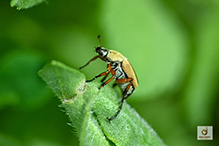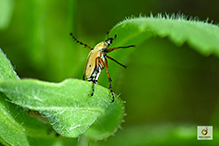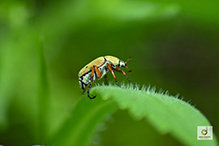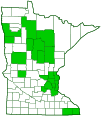American rose chafer
(Macrodactylus subspinosus)
Conservation • Description • Habitat • Ecology • Distribution • Taxonomy
|
|
||||||||||||||
Description |
American rose chafer is a native, small, scarab beetle. It is found in the United States and southern Canada east of the Great Plains. It is common and sometimes abundant throughout most of its range, but it is mostly absent from the deep south. It is common and sometimes locally abundant in Minnesota. American rose chafer is found in a wide variety of habitats, including old fields, field edges with vines, orchards, nurseries, and gardens, but always near areas with sandy soil. The larvae live in the soil and feed on the roots of mostly grasses but also other plants. Adults appear, often in great numbers, in early to mid-June, and in six weeks they are entirely gone. They feed on the leaves, flowers, and fruit of almost any plant. When they were first noticed in 1810, American rose chafer was a pest of the flowers of roses and grapes. Since then, it has greatly extended its range of foods, to the point that it now feeds on almost any green plant. It is considered a minor pest, especially of rose, peony, and grape, but also of fruit trees, agricultural crops, vegetable gardens, ornamental plants, and shade trees in residential yards. The larvae need light sandy soil to successfully complete their development. This requirement prevents the species from becoming an even greater pest. Adults are 5⁄16″ to ½″ (8 to 13 mm) in length. The body is oblong oval, somewhat flattened, and mostly black. The upper parts of the body, including the head, the plate covering the first segment of the thorax (pronotum), and the wing covers (elytra), are densely covered with appressed, yellowish tan, hairlike scales. The sides and underside of the body are mostly covered with similar white scales. The scales on the head and pronotum tend to wear off with age, revealing the black color below. The mouth parts are reddish, inconspicuous, and directed downwards. The antennae are short. Two antennal segments near the end are long, flattened, and movable. Along with the long terminal segment, they form a club that can be spread out like a fan or contracted. The pronotum is widest and somewhat sharply angled in the middle, almost spine-like. This is the feature that gives the beetle its species epithet. The plate between the wing bases (scutellum) is visible. On the female, the pronotum is covered with erect hairs. On the male, there is a spine on the underside of the thorax between the bases of the front legs. When viewed from the side, the spine is half as long as the first segment (coxa) of each front leg. The elytra do not extend to the end of the abdomen. The legs are long, slender, and orange or reddish. On the hind legs, the fourth segment has a pair of spurs at the tip. The last part of each leg (tarsus) has five segments. On the middle and hind legs, the tarsus is longer than the tibia. This is the feature that gives the genus its scientific name – the suffix “-dactylus” is commonly used in Latin for things related to fingers or toes. Each tarsal segment is black at the tip. |
Size |
Total length: 5⁄16″ to ½″ (8 to 13 mm) |
Similar Species |
Habitat |
Old fields, field edges, orchards, nurseries, and gardens |
Ecology |
Season |
One generation per year: early June to late July |
Behavior |
|
Life Cycle |
Eggs are laid deep in the soil. When the eggs hatch, the larvae feed on the roots of grasses and other plants. In the fall, they burrow deeper in the soil, and they overwinter below the freeze line. They pupate in the spring just below the soil surface. |
Larva Food |
|
Adult Food |
|
Distribution |
||
|
Sources |
|
| 6/20/2024 | ||
Occurrence |
||
Common |
||
Taxonomy |
|
Order |
Coleoptera (Beetles) |
Suborder |
Polyphaga (Water, Rove, Scarab, Long-horned, Leaf, and Snout Beetles) |
Infraorder |
Scarabaeiformia |
Superfamily |
Scarabaeoidea (Scarabs, Stag Beetles, and Allies) |
Family |
Scarabaeidae (scarabs) |
Subfamily |
Melolonthinae (June beetles) |
Tribe |
Macrodactylini |
Genus |
Macrodactylus (American rose chafers) |
Subordinate Taxa |
|
|
|
Synonyms |
|
Macrodactylus barbatus Macrodactylus polyphagus Macrodactylus subspinosa Melolontha elongata Melolontha subspinosa |
|
Common Names |
|
American rose chafer rose-bug rose chafer |
|
Glossary
Coxa
The first (most proximal) segment of the legs of most arthropods, including all insects, spiders, and crustaceans, and most arachnids. It attaches the leg to the body and connects to the trochanter. Plural: coxae.
Elytra
The hardened or leathery forewings of beetles used to protect the fragile hindwings, which are used for flying. Singular: elytron.
Pronotum
The exoskeletal plate on the upper side of the first segment of the thorax of an insect.
Scutellum
The exoskeletal plate covering the rearward (posterior) part of the middle segment of the thorax in some insects. In Coleoptera, Hemiptera, and Homoptera, the dorsal, often triangular plate behind the pronotum and between the bases of the front wings. In Diptera, the exoskeletal plate between the abdomen and the thorax.
Tarsus
On insects, the last two to five subdivisions of the leg, attached to the tibia; the foot. On spiders, the last segment of the leg. Plural: tarsi.
Tibia
The fourth segment of an insect leg, after the femur and before the tarsus (foot). The fifth segment of a spider leg or palp. Plural: tibiae.
Visitor Photos |
||
Share your photo of this insect. |
||
This button not working for you? |
||
Mike Poeppe |
||
 |
 |
|
 |
|
|
MinnesotaSeasons.com Photos |
||
|
||
|
||

Visitor Videos |
||
Share your video of this insect. |
||
This button not working for you? |
||
|
Other Videos |
||
|

Created: 6/23/2024 Last Updated: © MinnesotaSeasons.com. All rights reserved. |




